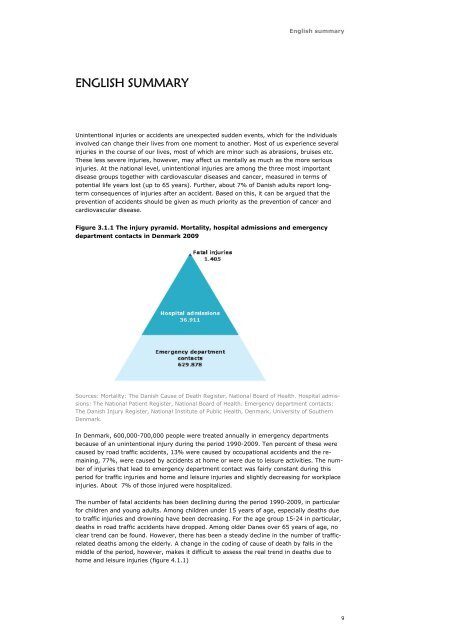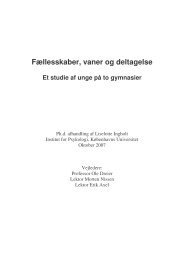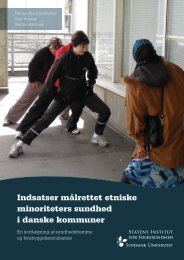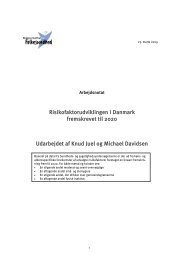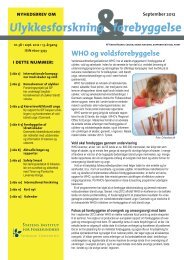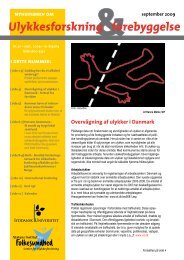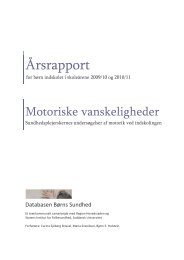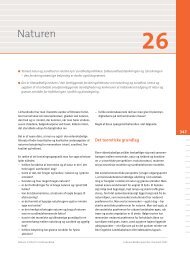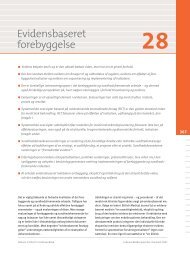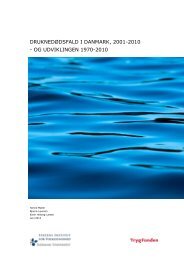Ulykker i Danmark 1990-2009 - Statens Institut for Folkesundhed
Ulykker i Danmark 1990-2009 - Statens Institut for Folkesundhed
Ulykker i Danmark 1990-2009 - Statens Institut for Folkesundhed
Create successful ePaper yourself
Turn your PDF publications into a flip-book with our unique Google optimized e-Paper software.
ENGLISH SUMMARY<br />
English summary<br />
Unintentional injuries or accidents are unexpected sudden events, which <strong>for</strong> the individuals<br />
involved can change their lives from one moment to another. Most of us experience several<br />
injuries in the course of our lives, most of which are minor such as abrasions, bruises etc.<br />
These less severe injuries, however, may affect us mentally as much as the more serious<br />
injuries. At the national level, unintentional injuries are among the three most important<br />
disease groups together with cardiovascular diseases and cancer, measured in terms of<br />
potential life years lost (up to 65 years). Further, about 7% of Danish adults report longterm<br />
consequences of injuries after an accident. Based on this, it can be argued that the<br />
prevention of accidents should be given as much priority as the prevention of cancer and<br />
cardiovascular disease.<br />
Figure 3.1.1 The injury pyramid. Mortality, hospital admissions and emergency<br />
department contacts in Denmark <strong>2009</strong><br />
Sources: Mortality: The Danish Cause of Death Register, National Board of Health. Hospital admissions:<br />
The National Patient Register, National Board of Health. Emergency department contacts:<br />
The Danish Injury Register, National <strong>Institut</strong>e of Public Health, Denmark, University of Southern<br />
Denmark.<br />
In Denmark, 600,000-700,000 people were treated annually in emergency departments<br />
because of an unintentional injury during the period <strong>1990</strong>-<strong>2009</strong>. Ten percent of these were<br />
caused by road traffic accidents, 13% were caused by occupational accidents and the remaining,<br />
77%, were caused by accidents at home or were due to leisure activities. The number<br />
of injuries that lead to emergency department contact was fairly constant during this<br />
period <strong>for</strong> traffic injuries and home and leisure injuries and slightly decreasing <strong>for</strong> workplace<br />
injuries. About 7% of those injured were hospitalized.<br />
The number of fatal accidents has been declining during the period <strong>1990</strong>-<strong>2009</strong>, in particular<br />
<strong>for</strong> children and young adults. Among children under 15 years of age, especially deaths due<br />
to traffic injuries and drowning have been decreasing. For the age group 15-24 in particular,<br />
deaths in road traffic accidents have dropped. Among older Danes over 65 years of age, no<br />
clear trend can be found. However, there has been a steady decline in the number of trafficrelated<br />
deaths among the elderly. A change in the coding of cause of death by falls in the<br />
middle of the period, however, makes it difficult to assess the real trend in deaths due to<br />
home and leisure injuries (figure 4.1.1)<br />
9


